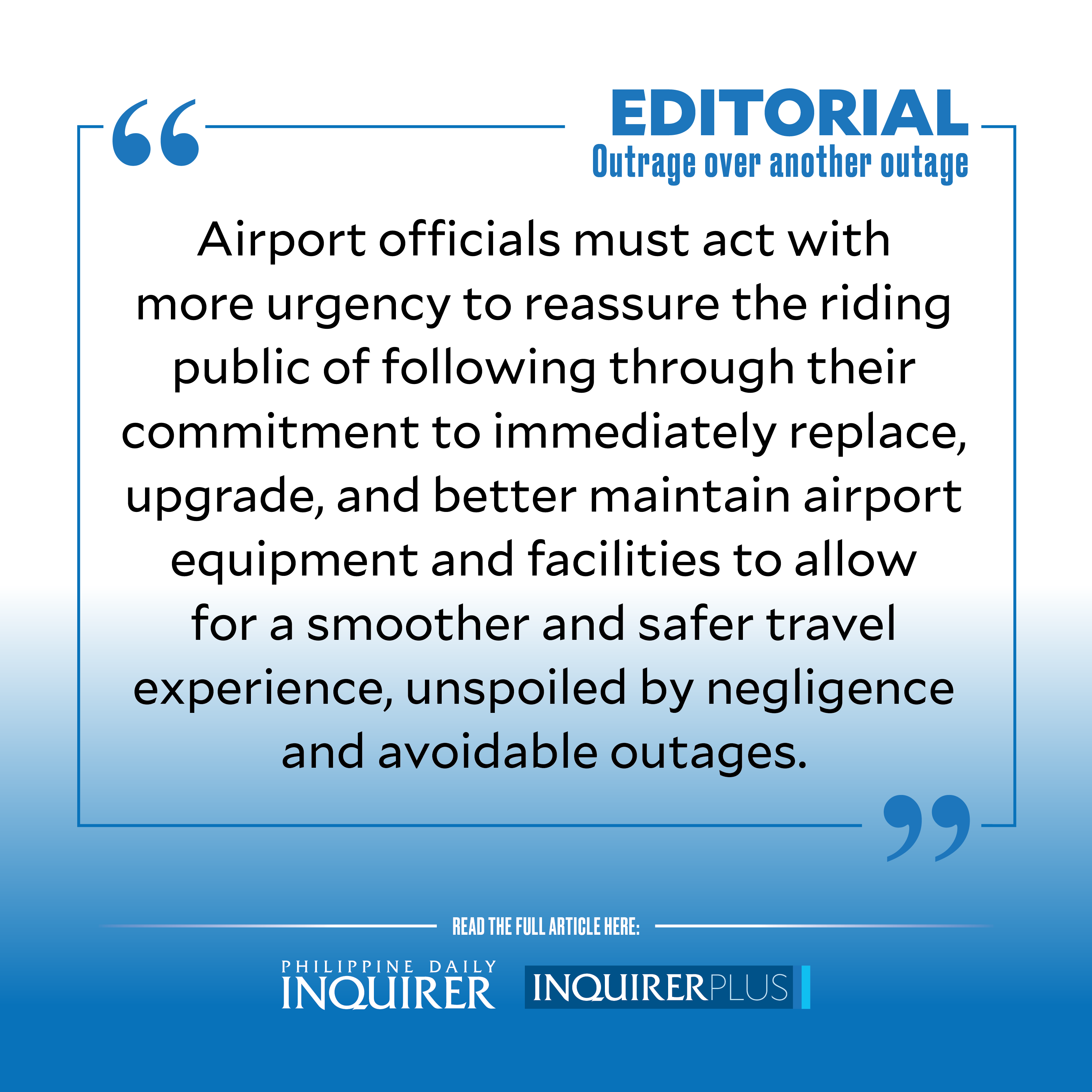Outrage over another outage
For the second time this year, flight operations at the Ninoy Aquino International Airport (Naia) were temporarily crippled by a sudden power outage, leaving thousands of travelers fuming as they make their way back after a long Labor Day weekend. Airport officials bore the brunt of the outrage as this was an entirely avoidable incident.
Power at Naia’s Terminal 3 was suddenly cut at 1 a.m. on Monday but completely restored at 8:46 a.m., by which time at least 48 domestic flights had been canceled or delayed, reinforcing the already dismal image of the airport as one of Asia’s most stressful. The Manila Electric Co. later traced the problem to a “fault current” or an uncontrolled, high current flow that tripped the circuit breakers and plunged the airport swelled by holiday travelers into chaos. The scene is reminiscent of the Jan. 1 power outage that disrupted 361 flights and affected 65,000 passengers.
Article continues after this advertisementWhile Transportation Secretary Jaime Bautista and other airport officials had committed in the aftermath of the unfortunate event that they are doing everything so it won’t happen again, senators placed the blame squarely on parties overseeing airport operations. Sen. Nancy Binay said the May 1 outage showed “how weak, bad, and vulnerable our airports are,” thus sending local and foreign tourists the message that “traveling in the Philippines has become an unpleasant and frustrating experience.” Citing a string of technical glitches, Binay described the gateway to the Philippines as “a port of inconvenience to travelers and tourists.”
Sen. Jinggoy Estrada said it was particularly frustrating that the Department of Transportation (DOTr) and the Manila International Airport Authority (MIAA) had more than enough time to act on the immediately actionable recommendations laid out by the Senate in March, when it concluded its probe into the Jan. 1 power outage. In its report, the Senate identified the absence of redundancy or systems backup and the lack of maintenance of airport equipment as the main causes of the disruption.
Following the Senate’s detailed recommendations would have spared passengers the inconvenience and expense of delayed and canceled flights, and airlines business losses from ticket refunds. So what happened to the backup and redundancy systems that the DOTr and MIAA had promised to immediately put in place? Given what happened this week, one can only conclude that the concerned parties had dragged their feet, absurdly confident about the odds of the same fiasco happening a mere four months since.
Article continues after this advertisementProviding some small consolation is the fact that airport authorities seem to have been finally jolted into action by the latest power outage, thus the scheduled shutdown of the country’s airspace from midnight to 6 a.m. on May 17 to give way—finally—to the overdue maintenance and upgrade of the Civil Aviation Authority of the Philippines’ Philippine Air Traffic Management Center, that manages and supervises air traffic activities. Bautista has also committed to conduct a “full electrical audit” for all terminals to avoid future power interruptions. The results of the full electrical audit will allow the MIAA to determine which critical equipment and services needed to be replaced, with the subsequent procurement projected to cost about P1 billion. The amount should cover the installation of enough generators to power 100 percent of Naia’s needs.
The MIAA’s delayed proposal however did not sit well with Sen. Grace Poe, who described it as another indication of the lack of planning among airport officials. “Clearly, they have been remiss in their duties by not proposing an upgraded backup system,” said Poe.
The possibility that sabotage was behind the incident was floated as well, given that both outages happened during a holiday. Said Bautista: “I think you cannot really discount the possibility of having somebody [doing] it to embarrass the government, or to prove they have [a bargaining chip] and therefore we should give in.” He has begun coordinating with the National Intelligence Coordinating Agency, the National Bureau of Investigation, and the Philippine National Police to look into possible security issues, he added.
“There are claims that it was not a regular fault that entered the system in Terminal 3,” explained Bautista, a fear also expressed by MIAA general manager Cesar Chiong. The claim of possible sabotage has raised eyebrows, with observers saying that it may just be a convenient excuse for the lack of foresight and action among airport and transportation officials in the months between the two massive disruptions at the airport. Such suspicions might be worth pursuing, however, to rule out foul play, in the same way that initial investigation ruled out a cyberattack and hacking.
At the same time, airport officials must act with more urgency to reassure the riding public of following through their commitment to immediately replace, upgrade, and better maintain airport equipment and facilities to allow for a smoother and safer travel experience, unspoiled by negligence and avoidable outages.

















